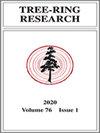SAPWOOD RINGS ESTIMATION FOR PINUS SYLVESTRIS L. IN LITHUANIA AND LATVIA
IF 1.1
4区 农林科学
Q3 FORESTRY
引用次数: 4
Abstract
ABSTRACT Pinus sylvestris L. is the predominant tree species used for wooden constructions in the Baltic area. Accordingly, the timber of Pinus is the most important object for investigation and dating carried out by dendrochronologists of the Baltic countries. However, the dating of historical Pinus is often challenging when the outer sapwood rings are missing in the wood samples. In Pinus, sapwood rings increase in number as the tree ages, and therefore calculating the approximate number of missing outer rings from a set range, a technique used for oak, is not possible. In Norway, a simple method for estimating the number of sapwood rings has been developed for some native species of conifers. The aim of this small-scale study was to assess the validity and the practical suitability of the Norwegian method for estimating the number of missing sapwood rings of mostly historical Pinus wood samples obtained in the southeastern part of the Baltic region. Our findings indicate that this method is not acceptable for estimating the number of missing sapwood rings for individual trees, but suggest that it may be applicable when dating tree-ring chronologies for a minimum of 20 trees, containing individuals up to 200 years old.立陶宛和拉脱维亚樟子松边材年轮的估算
摘要:樟子松是波罗的海地区用于木制建筑的主要树种。因此,松树木材是波罗的海国家树木学家进行调查和测年的最重要对象。然而,当木材样本中缺少外部边材环时,历史松的年代测定往往具有挑战性。在松属植物中,边材环的数量随着树龄的增长而增加,因此无法从一个设定的范围内计算出缺失外环的大致数量,这是一种用于橡树的技术。在挪威,已经为一些本土针叶树物种开发了一种估算边材环数量的简单方法。这项小规模研究的目的是评估挪威方法的有效性和实际适用性,该方法用于估计在波罗的海地区东南部获得的大部分历史松木样本的边材环缺失数量。我们的研究结果表明,这种方法不可用于估计个别树木缺失边材环的数量,但表明它可能适用于至少20棵树木的年轮年表,其中包括200岁以下的树木。
本文章由计算机程序翻译,如有差异,请以英文原文为准。
求助全文
约1分钟内获得全文
求助全文
来源期刊

Tree-Ring Research
农林科学-林学
CiteScore
2.40
自引率
12.50%
发文量
15
审稿时长
>36 weeks
期刊介绍:
Tree-Ring Research (TRR) is devoted to papers dealing with the growth rings of trees and the applications of tree-ring research in a wide variety of fields, including but not limited to archaeology, geology, ecology, hydrology, climatology, forestry, and botany. Papers involving research results, new techniques of data acquisition or analysis, and regional or subject-oriented reviews or syntheses are considered for publication.
Scientific papers usually fall into two main categories. Articles should not exceed 5000 words, or approximately 20 double-spaced typewritten pages, including tables, references, and an abstract of 200 words or fewer. All manuscripts submitted as Articles are reviewed by at least two referees. Research Reports, which are usually reviewed by at least one outside referee, should not exceed 1500 words or include more than two figures. Research Reports address technical developments, describe well-documented but preliminary research results, or present findings for which the Article format is not appropriate. Book or monograph Reviews of 500 words or less are also considered. Other categories of papers are occasionally published. All papers are published only in English. Abstracts of the Articles or Reports may be printed in other languages if supplied by the author(s) with English translations.
 求助内容:
求助内容: 应助结果提醒方式:
应助结果提醒方式:


